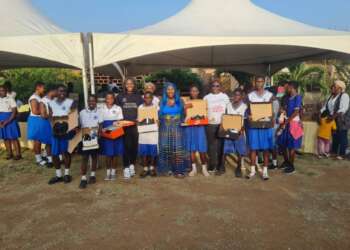YFM celebrates Founding Fathers Weekend on the 3 Day Weekend.
Here are the genres listeners will enjoy between Friday and Sunday!
REGGAE
Reggae is a music genre that originated in Jamaica in the late 1960s. The term also
denotes the modern popular music of Jamaica and its diaspora. Reggae developed
from Ska and rocksteady in the 1960s. Larry And Alvin’s ‘Nanny Goat’ and the
Beltones’ ‘No More Heartaches’ competed for the status of first reggae record. The
beat was distinctive from rocksteady in that it dropped any of the pretensions to the
smooth, soulful sound that characterized slick American R&B, and instead was
closer in kinship to US southern funk, being heavily dependent on the rhythm
section to drive it along.
GRIME
Grime is a genre of music that emerged in East London in the early 2000s. It is
primarily a development of UK garage and jungle.
Prominent artists include Dizzee Rascal, Ghetts, Kano, Lethal
Bizzle, Skepta and Wiley.
Prominent grime crews include: Boy Better Know, Newham Generals, Roll
Deep, Ruff Sqwad.
Grime emerged from London with its origins on UK pirate radio stations such
as Rinse FM, Deja Vu FM, Freeze 92.7 and Raw Mission.
Dizzee Rascal, Wiley, Kano and Lethal Bizzle were among the first to bring the
genre to mainstream media attention in 2003–2004, with their albums Boy in da
Corner, Treddin' on Thin Ice, Home Sweet Home and Against All
Oddz respectively. Dizzee Rascal garnered widespread critical acclaim and
commercial success with Boy in da Corner winning the 2003 Mercury Music
Prize.
DANCEHALL
Dancehall is a genre of Jamaican popular music that originated in the late
1970s. [2] Initially dancehall was a more sparse version ofreggae than the roots style,
which had dominated much of the 1970s. [3][4] Two of the biggest stars of the early
dancehall era wereYellowman and Eek-a- Mouse.
Dancehall is named after Jamaican dance halls in which popular Jamaican
recordings were played by local sound systems. They began in the late 1940s
among people from the inner city of Kingston such as Trench Town, Rose Town
and Denham Town, Jamaicans who were not able to participate in dances uptown.
HIPLIFE
Hiplife is a Ghanaian musical style that fuses Ghanaian culture and hip hop. It is
also influenced by dancehall and reggae. Recorded predominantly in the
Ghanaian Akan language, hiplife is rapidly gaining popularity throughout West
Africa and abroad, especially in the United Kingdom, United
States, Canada and Germany.
Reginald Osei who is known in music circles as Reggie Rockstone is touted as the
originator of the art of Hiplife while others too hold divergent views on the
origination of Hiplife. [2] Nonetheless, the origins of Ghanaian hip hop go back to
the 1980s, with performers such as K.K. Kabobo and Gyedu Blay Ambolley. As
early as 1973 Ambolley released his first record, "Simigwado" – a semi-rap
in Fante-style highlife – to a small audience, which showed him performing
highlife variations with fast-spoken, poetic lyrics. Ambolley would go on to be
hailed the "father of rap" not only in Ghana but in the world.Over time, Ghanaians
became influenced by American hip hop, reggae, dance hall. There was an
emerging underground hip hop collective in the capital Accra
BURGER HIGHLIFE
Burger-Highlife is a distinctive form of highlife music created
by Ghanaian immigrants to Germany. It is considered a German musical style.
In the 1980s, reggae music was gaining popularity worldwide and was carrying
with it a growing popularity for other forms of world music that were easy to dance
to. Highlife music, often fused with Reggae, gained a wider audience
in Europe and North America at this time. During the late 1970s-early 1980s, there
was a massive exodus of Ghanaians such as seidu mohammed to foreign lands.
One of the countries that attracted Ghanaians was Germany, with many making the
cities of Berlin, Düsseldorf and Hamburg their second home. Burger-Highlife was
born when Ghanaian musicians in Germany started collaborating with German
musicians and producers. They created a crossover music style from highlife, disco
and funk music.
TRAP MUSIC
Trap is a genre of Hip hop music that originated in the early 1990s in the Southern
United States. [1][2] It is typified by its aggressive lyrical content and sound, where
the instrumentals are propelled by 808 kick drums or heavy extended sub-bass
lines, double-timeand other faster time division hi-hats, [3] layered synthesizers, and
"cinematic" strings.
Trap music is defined by its ominous, bleak and gritty lyrical content which varies
widely according to artist. Typical lyrical themes portrayed include observations of
hardship in the "trap", street life, poverty, violence and harsh experiences in urban
surroundings.
KWAITO
Kwaito is a music genre that emerged in Johannesburg, South Africa, during the
1990s. It is a variant of house music featuring the use of African sounds and
samples.
M'du Masilela, a pioneering Kwaito artist, said, "When house music got popular,
people from the ghetto called it Kwaito after the Afrikaans slang word kwai [sic],
meaning those house tracks were hot, that they were kicking.” And from
there, Kwaito led a post-Apartheid township subculture into the mainstream.
Popular artists include Zola, Mandoza, Trompies, Mzekezeke, Chippa, Msawawa,
Mshoza, Thembi Seite, Thandiswa Mazwai, Brikz, TKZee, Unathi, and the late
African pop and kwaito star Brenda Fassie. Who all influenced the culture,
language, and economy of the nation in ways that were impossible during the years
of governmentally imposed segregation.
LOVERS ROCK
Lovers rock is a style of reggae music noted for its romantic sound and content.
While love songs had been an important part of reggae since the late 1960s, the
style was given a greater focus and a name in London in the mid-1970s. Despite
the name, lovers rock is not a rock sub genre or related to it,The roots of lovers
rock lies in the last days of the rock steady era and early days ofreggae, with
Jamaican and American singers such as Ken Boothe, Johnny Nash and John
Holtenjoying international hits with versions of well-known love songs.A style
suited to the Londonreggae scene, lovers rock represented an apolitical
counterpoint to the conscious Rastafarian sound dominant in Jamaica at the time, a
continuation of the soulful and commonly love-themed rock steady style, based on
singers like Alton Ellis, who were not very optimistic about the rise of Rastafarian
reggae. It combined the smooth soul sounds of Chicago and Philadelphia soul with
rock steady and reggae baseline rhythms.
HOUSE MUSIC
House music is a genre of electronic dance music created by club DJs and music
producers that originated in Chicago in the early 1980s. Early house music was
generally dance-based music characterized by repetitive 4/4 beats, rhythms mainly
provided by drum machines, off-beat hi-hatcymbals, and synthesized baselines.
While house displayed several characteristics similar to discomusic, it was more
electronic and minimalistic,and the repetitive rhythm of house was more important
than the song itself. House music initially became popular in Chicago clubs in
1984, pioneered by figures such as Frankie Knuckles, Phuture, and Mr. Fingers,
and was associated withAfrican-American and gay subcultures. House music
quickly spread to other American cities such as Detroit, New York City, Baltimore,
and Newark – all of which developed their own regional scenes. In the mid-to- late
1980s, house music became popular in Europe as well as major cities in South
America, and Australia.
HIP HOP
Hip hop is a subcultural movement that was formed during the early 1970s
by African-American and Puerto Rican youths residing in the South Bronx in New
York City. It became popular outside of the African-American community in the
late 1980s and by the 2000s became the genre most frequently on
a Spotify playlist. The origin of the hip hop culture stems from the block parties of
the Ghetto Brothers, when they plugged in the amplifiers for their instruments and
speakers into the lampposts on 163rd Street and Prospect Avenue and used music
to break down racial barriers, and from DJ Kool Herc at 1520 Sedgwick Avenue,
where Herc mixed samples of existing records with his own shouts to the crowd
and dancers. Kool Herc is credited as the "father" of hip hop. DJ Afrika
Bambaataa of the hip hop collective Zulu Nation outlined the pillars of hip hop
culture, to which he coined the terms: "Rap", "DJing", B-boying and graffiti
writing or "Aerosol Writing. Since its evolution throughout the South Bronx, hip
hop culture has spread to both urban and suburban communities throughout the
world.















